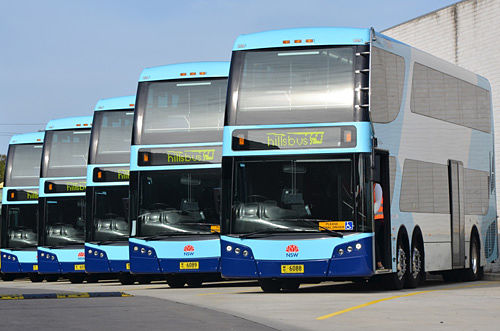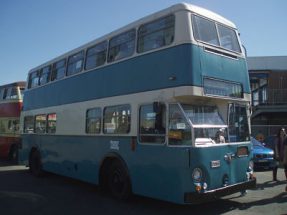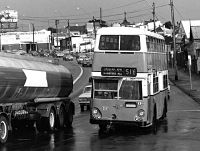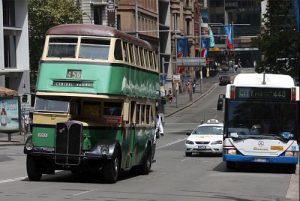
Double decker buses will soon become a common sight on Sydney’s streets once more after the New South Wales Government revealed it will commission a proper fleet of the high capacity vehicles to boost capacity on crowded runs as part of a $108 million service boost and refresh in the 2016-17 NSW Budget
Exact details on who will manufacture and how many of the new 80-seat beasts will be deployed are still to be finalised, but the firm commitment to reinstate double deckers into mainstream route service in Sydney cements major turnaround in public transport thinking 30-years after the last Leyland Atlantean made its from Wynyard to Avalon in May 1986.

While the Baird Government started trialling Bustech double deckers North-West T-Way at the end of August 2012, the pre-Budget essentially embeds the top deck vehicles as part of the city’s core fleet for the foreseeable future.
The announcement is also the second major public transport ‘back to the future’ flip for Transport for NSW after the commitment to reinstate light rail services (or heavy trams) in the city and eastern suburbs, with deployments in the West also highly likely to be commissioned.
Heavy crowding and more demand than capacity during peak-hour services for Sydney buses has been a serious and persistent problem for at least the last decade, as urban renewal and residential infill push more commuters onto the bus system.
The biggest headaches for authorities and commuters alike include passengers who are closer to a bus route destination often missing out on scheduled morning trips because vehicles are filled to capacity well before they get near their terminus.
Efforts to deploy more, larger single decker and articulated or ‘bendy’ busses have also created knock-on effects as busses get stuck long queues to unload passengers on approaches to the city and other major centres.
A big benefit of double decker buses is that even though they carry 65 per cent more passengers than regular buses – 130 people when completely full on seated and standing capacity – they only occupy the space of a single bus making it easier to cram more services into smaller areas and tighter streets.
 With major residential developments now replacing industrial real estate on the city fringe, authorities are looking to boost both capacity and frequency.
With major residential developments now replacing industrial real estate on the city fringe, authorities are looking to boost both capacity and frequency.
“Thousands of Sydneysiders rely on bus travel every day to get from A to B and we know demand for services is continually increasing, particularly in growth centres in the North West and South West, as well as in inner city areas like Green Square,” said NSW Transport Minister Andrew Constance.
“Since coming to office, the NSW Government has delivered more than 15,800 extra weekly public transport services for customers and today’s announcement is further proof that we’re committed to putting on even more where and when they’re needed most.
“This is all about staying ahead of the curve to ensure customers have sufficient levels of service well into the future.”
 For people that remember Sydney’s original double decker bus fleet, it’s actually more like replacing something many feel, like trams, should never have been taken away in the first place.
For people that remember Sydney’s original double decker bus fleet, it’s actually more like replacing something many feel, like trams, should never have been taken away in the first place.
Treasurer Gladys Berejiklian – who spearheaded many of the key public transit reforms when she held the Transport portfolio – said the upcoming NSW Budget would continue to fund more services and infrastructure.
“These double decker buses have allowed us to deliver good customer outcomes and we are pleased to be rolling out more of them across Sydney,” Ms Berejiklian said before cataloguing where new money was going to be spent.
The Treasurer said that under the NSW Budget 2016-16 commitment, 12 new or extended routes will come online. They include a new cross suburban link between the Inner West and Lower North Shore, all night services seven days a week for Green Square and Zetland as well as Abbotsford, Five Dock and Rouse Hill on weekends.
The addition of new all-night services has long been called for by groups representing essential services and the hospitality sector where the availability and cost of labour have been hit by the shortage of car spaces and a lack of alternative transport options.
Fleet renewal and replacement is also a strong focus, with older non-air conditioned buses finally dropped from service in favour of climate controlled accessible (or ‘kneeling’) busses that allow wheelchair users to roll-on and roll-off regular services – an important addition given many older Sydney railway stations still don’t have lifts.
Specifics for the 2016/17 Growth Bus Services Program
Western Sydney (including Hills District and South West)
More than 1,350 new weekly trips, including 5 new or extended routes.
- New route 605 (North Kellyville to Rouse Hill Town Centre)
- Extended route 751 (Marsden Park to Blacktown via Colebee)
- Extended route T72 (Blacktown to Rouse Hill Town Centre via Alex Avenue)
- Extended route T74 (Blacktown to Riverstone via Hambledon Road)
- Extended route 783 (Penrith to Jordan Springs)
Enhanced services:
- 607X (Rouse Hill to City via M2)
- 610X/M61 (Rouse Hill and Castle Hill to City M2)
- 611 (Blacktown to Macquarie Park via M2)
- 615X (North Kellyville to City via M2)
- 619 (Rouse Hill to Macquarie Park via Kellyville and M2)
- 620X-621 (Castle Hill and Cherrybrook to Macquarie Park and City via M2)
- 700 (Blacktown to Parramatta via Prospect)
- 740 (Plumpton to Macquarie Park via M2)
- 841 (Narellan to Leppington)
- T65 (Rouse Hill to Parramatta via Westmead)
- T80 (Liverpool to Parramatta via Bonnyrigg)
Sydney Metropolitan
More than 1,950 new weekly trips, including 2 new routes.
- New route 530 (Burwood to Chatswood via Five Dock, Hunters Hill and Lane Cove)
- New route 985 (Miranda to Cronulla via Woolooware Shores)
Enhanced services on the following routes:
- Various Northern Beaches routes between Mona Vale and the City
- 197 (Mona Vale to Macquarie Park via Terrey Hills)
- 270-274 (Frenchs Forest District to City)
- 343 (Kingsford to City)
- 370 (Leichhardt to Coogee)
- 433 (Balmain to Railway Square via Harold Park)
- 477 (Miranda to Rockdale via Sans Souci)
- 506 (Macquarie University and East Ryde to City via Hunters Hill)
- 518 (Macquarie University to City via Ryde)
- M20 (Zetland to Wynyard via Central Station)
- M41 (Burwood to Macquarie Park via Ryde)
New all-night services on the following routes:
- 301 (Zetland to City via Surry Hills) – seven days
- 438 (Abbotsford to City via Five Dock and Leichhardt) – Friday and Saturday only
- 607X (Rouse Hill to City via M2) – Friday and Saturday only
Lower Hunter – More than 170 new weekly trips, including 2 new or extended routes:
- New route 178 (Anambah to Rutherford)
- Extended routes 260 and 261 (Minmi and Fletcher to Jesmond and University)
Central Coast – 45 new weekly trips, including 1 extended route:
- Extended route 40 (Gosford – Wyoming)
- Enhanced services on routes 67 and 68 between Terrigal and Gosford
- Enhanced services on route 33 between Gosford and Mangrove Mountain
Blue Mountains – More than 30 new weekly trips on route 686 between Katoomba, Echo Point and Scenic World
Illawarra – More than 240 new weekly trips, including 2 new or extended routes:
- New route 75 (Tullimbar to Stockland Shellharbour)
- Extended route 32 (Dapto to Brooks Reach)
- Enhanced services on route 1 between Austinmer and Wollongong
- Enhanced services on routes 31-33 between Wollongong and Dapto District
- Enhanced services on route 34 between Warrawong and Wollongong
Comment below to have your say on this story.
If you have a news story or tip-off, get in touch at editorial@governmentnews.com.au.
Sign up to the Government News newsletter

As a student in Sydney in the 1960’s I worked as a “clippy” on the old cream green and brown liveried double decker buses.
Although this was in the days before air-conditioning I was always amazed at the paint scheme whereby the top deck roof was painted brown (and with no internal insulation). In summer passengers on the longer routes to the Northern Beaches were “cooked” in the evening home run.
Open the narrow front window and the top deck became effectively a fan assisted oven. I often wondered why there was not a push to at least change the colour scheme to reflect some of the sun’s heat, and the stupidity in the first place of selecting a brown painted roof!
I may have been one of your drivers,I drove out of Brookvale 1964-1970. regards Philip Marks.
I believe the government have already purchased 30
Jamalang double decker from Malaysia…
Who are the Distributors for these vehicles
Please reply.
My interest is in supplying glass to these
Vehicles in the future…